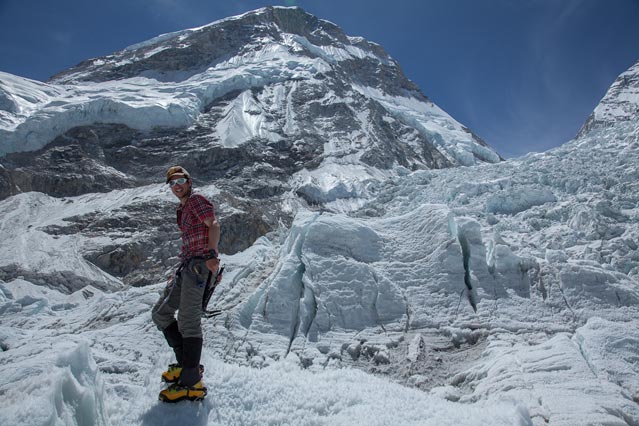You originally went over to Base Camp with the intention of covering a serious expedition up one of the mountain’s most technical routes. What happened to those guys?
I arrived here April 19th and have been here throughout the entire season with the Eddie Bauer West Ridge Expedition. These are four guys who are trying to climb a different and much more difficult route than the standard guided route, but unfortunately the conditions were just too difficult and they’ve called off their expedition as of about two days ago.
Before we talk about what went wrong this weekend, can you tell me what Base Camp is like? I think most people don’t realize how, ah, civilized it is.
Base Camp forms in early April and this year there are close to 1,000 people here. It’s like a small city, with everything from a helicopter landing pad to an emergency room. It’s supplied by yaks and porters and helicopters. It has wireless Internet and 3G cell-phone connections. Everest Base Camp is actually one of the most well-connected wildernesses in the world. The idea that people are out here roughing it is sort of a misnomer.
Back in 1996, when the Everest disaster that led to Jon Krakauer’s bestseller occurred, there were only a handful of outfitters here. Now there are closer to a dozen, and the clients are paying anywhere from $25,000 to go with a local outfitter, to $80,000 to go with the most reputable Western outfitters. Back in 1996, a big deal was made of climbers who supposedly didn’t have much experience because they’d only climbed a few peaks around the world. But now you literally have people showing up at Base Camp who have never strapped on crampons before, have never climbed any mountain, who are trying this. So the level of experience has fallen off dramatically, while at the same time the number of people has increased just as dramatically.
Are there more people there than in previous years?
Well, there are definitely a lot of people, but probably not too many more than normal this year. The biggest problem this year has been the way the weather window is set up, everybody tried to funnel into the same first summit window, so what we had was a situation where there was a clear period of about two days of good weather but about 300 people who were trying to make their summit bids in that time.
And that’s partly because this first weather window occurred later in the month, right?
Exactly. So what happens is, most people get here sometime in April and they’ll do two or three rotations up the mountain where they’ll climb incrementally higher, up to Camp II, Camp III, and eventually Camp IV at about 26,000 feet, and then everybody goes down the mountain and waits for the perfect window when temperatures get up toward zero and the winds drop from 70-80 miles per hour down to 20 or 30 miles per hour. Normally you’ll get a number of these windows where people will sort of filter into them and go about it in an organized fashion. But this year, because of the way things shaped up, everyone just started going at once.
Whereas usually the summit bids are more spread out.
During a more normal year, people would have started summiting in the second week of May. But the first window didn’t happen until last weekend, into the third week of May. The route to the summit was only fixed by teams of Sherpas on May 18th, so that leaves really only about a week or 10 days before the monsoon season sets in and the mountain becomes unclimbable, so I think people were a little more anxious than normal this year.
That’s a critical point, the fixed lines. I don’t think people really understand what you mean when you say traffic jam.
Everest is unusual in that the mountain is stitched together with what are called fixed lines. Every season, teams of Sherpas will go up and put miles and miles of rope through the Khumbu Icefall, which is at the bottom of the mountain, all the way to the summit. So people will be climbing roped in to these fixed lines, so there’s not really a way to safely pass other climbers who are moving slowly—basically the line moves at the speed of the slowest climber.
I talked to a guide yesterday who said he waited during his summit bid for three and a half hours at the Hillary Step, which is one of the last big cliffs just before the summit. Waiting three and a half hours above 28,000 feet, where the Hillary Step is, is just far too long to not be moving. And when you stop moving, your body stops generating heat, so it just creates a very dangerous situation up there.
The whole idea is to get up there, and then back down, as quickly as possible.
That’s right. Usually on a summit bid, teams will leave the evening before they plan to summit, anywhere between 7 p.m. and 10 p.m. and climb through the night into the morning and summit sometime in the morning the following day. Most of these teams observe a strict turnaround time where, if the guide who’s with them doesn’t think that they’re going to make it to the top at a reasonable hour, they’ll turn around, but as you said, people are very determined to make it to the summit. They’ve paid a lot of money to be here and oftentimes it’s very difficult to get them to turn around.
The four deaths that occurred during last weekend’s weather window weren’t related, correct?
They were all separate incidents, but there is one thing that relates them—and this is kind of troubling. Each of these people was climbing with a local Nepalese outfitter, and climbing only with local Sherpas, and the reason that’s difficult is, I think there’s a tendency for some of these strong minded, type-A foreigners to steamroll their local guides and convince them that they need to go to the top. I talked to Sherpas who work with the outfitters that two of the deceased people were climbing with. In each case, they said that they were pleading with the climbers to turn back, but in both cases the climber said “No, no, no, I have to make it to the top. I have to get the summit photos.” The Western guides I’ve spoken with all stressed that one of the things that people are paying for is the judgement. And, certainly, with the guides I’ve spoken to, when they say “it’s time to turn around,” they mean it’s time to turn around.
Then there’s the hard work of getting down.
Exactly. Three out of the four of these people were descending after summiting. And you know, there’s a famous saying in mountaineering that the summit is only half-way. Most accidents happen on the descent. You’re exhausted. You’ve been going for 12, 13, 14 hours. Think about exercising as hard as you can for 24 straight hours. Some people do 24-hour mountain biking races and whatnot, but if you imagine trying to do that same athletic output above 28,000 feet, it’s so difficult that you just push yourself straight through to exhaustion.
I’ve read that some people are worried about another traffic jam forming this weekend, when as many as 200 people might try to summit.
I think 200 might be a little bit high, but probably somewhere between 100 and 200 will try. The next summit window is predicted to start the evening of May 24th. People will probably be leaving Camp IV at about 26,000 feet, climbing through the night and trying to summit on May 25th. A lot of the climbers who are going to be trying to summit in this next window are the most experienced climbers. A lot of the professionals have hung back and are going to be trying it in this window. So we’re hopeful that this time things will go a lot more smoothly.
Having been at Base Camp for so long, do you have a better sense for why so many people are still obsessed with climbing Everest?
I don’t quite understand the appeal myself. The mountain hasn’t bitten me the way it’s bitten others, but I think there’s still some appeal about it being the biggest one, the tallest one. I think that holds a certain cache for a lot of people to go back to their lives being an Everest summiter. Certainly there are people who just want to climb for the beauty of the mountain, but most of those people now head elsewhere, as nearly all of the other peaks over here are completely empty. But still, I think for many people, there’s just something that’s really easy to grasp about Everest being the tallest mountain in the world.
To commemorate the 50th anniversary of the first American ascent of Everest and its then-unclimbed West Ridge, Eddie Bauer has sent a team of seven mountaineers to repeat the historic climbs. �����ԹϺ��� Magazine senior editor Grayson Schaffer is currently embedded with the team at Base Camp, sending back daily dispatches, including stories, photos, and videos. A team sponsored by The North Face and National Geographic is also planning on ascending the notoriously treacherous West Ridge, a route nearly as many climbers have died on as have summitted. Schaffer will be covering both attempts, as well as everything else that happens at Base Camp, until early June.


